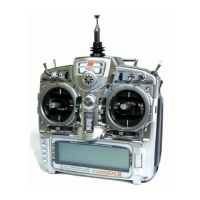15 General Section
Installation Requirements
It is extremely important that your radio system be
correctly installed in your model. Here are a few
suggestions for installing your JR® equipment:
1. Wrap the receiver in protective foam rubber that is no
less than 1 cm inch thick. Secure the foam to the
receiver with rubber bands. This protects the receiver
in the event of a crash or a very hard landing.
2. The servos should be mounted using rubber
grommets and brass eyelets to isolate them from
vibration. Do not over-tighten the mounting screws;
this will negate the vibration absorption effect of the
rubber grommets. The following diagram will assist
you in properly mounting your servo.
The brass eyelets are pushed from the bottom up in
the rubber grommets. When the servo screw is
tightened securely, it provides the proper security as
well as the proper vibration isolation for your servo.
3. The servos must be able to move freely over their
entire range of travel. Make sure that the control
linkages do not bind or impede the movement of any
of the servos.
4. Mount all switches away from the engine exhaust
and away from any high vibration areas. Make sure
the switch operates freely and is able to operate over
its full travel.
5. Mount the receiver antenna firmly to the airplane to
ensure that it will not become entangled in the
propeller or control surfaces.
Flash Memory
All preprogrammed data is protected by a flash memory
that guards against main transmitter battery failure.
Battery Alarm and Display
When the transmitter voltage drops below 9.0 volts DC,
the display flashes “BATT LOW” and an alarm sounds.
If you are flying when this occurs, land immediately.

